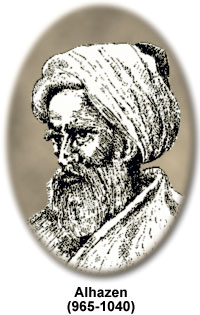Alhazen
(965-1040)

Born in Iraq as Abu Ali Hasan Ibn al-Haitham, the great Arab physicist is more often known by the Latinized version of his first name, Alhazen. Although he was to eventually become a profound intellectual specializing in mathematics and optics, Alhazen's early education was geared towards religion and prepared him for a career as a minister. However, apparently unhappy in his religious pursuits, Alhazen later decided to devote himself to the study of science and became particularly intrigued by Aristotle.
Many details of Alhazen's life have been lost over time and the stories that remain are often contradictory depending on the historian relating them. Nevertheless, it is generally held that Alhazen went to Egypt at some point in his life with a scheme to control the waters of the Nile. Invited to engineer the plan by al-Hakim, who was to become known as the Mad Caliph, Alhazen realized the impossibility of the feat. However, although he failed, al-Hakim rewarded him with an official government post, a gift that was not to be envied. As al-Hakim's behavior became increasingly erratic, Alhazen is believed to have feared for his life, feigning madness in order to be relieved of his position. Consequently, he was largely confined to his house until al-Hakim's death in 1021. Such a situation provided him with large amounts of free time with which he could conduct experiments and write, but he may have also been busy copying manuscripts in order to support himself.
The efforts of Alhazen resulted in over one hundred works, the most famous of which was Kitab-al-Manadhirn, rendered into Latin in the Middle Ages. The translation of the book on optics exerted a great influence upon the science of the western world, most notably on the work of Roger Bacon and Johannes Kepler. A significant observation in the work contradicted the beliefs of many great scientists, such as Ptolemy and Euclid. Alhazen correctly proposed that the eyes passively receive light reflected from objects, rather than emanating light rays themselves. The work also contained a detailed examination of the laws of reflection and refraction, which is accurately explained by the slower movement of light through denser substances. Furthermore, the question known as Alhazen's problem, which involves determining the point of reflection from a surface given the center of the eye and the observed point, is presented and answered through the use of conic sections.
Alhazen published several other less well-known works on optics, one of which included an account of the camera obscura, as well as books in many other fields, such as astronomy, mathematics, and even evolutionary biology. Other accomplishments he is frequently credited with are the development of analytical geometry and scientific methodology. Moreover, Alhazen was greatly interested in movement and is likely the earliest person to have suggested that a body moves continuously until an outside force stops it or changes the direction of its motion, which was to later become an important aspect of Newton's First Law of Motion.
